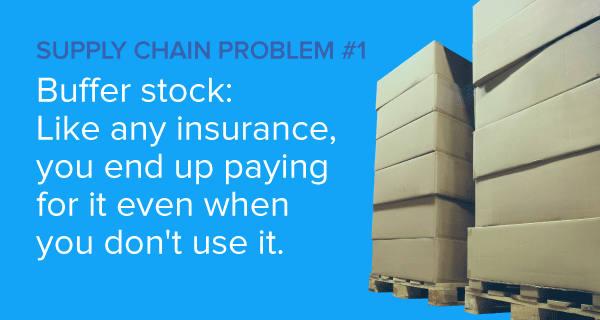Suhas Sreedhar & Brittany Brown, GT Nexus
Despite sophisticated forecasting formulas and planning expertise, balancing inventory (matching supply with demand) is still far from an exact science. It’s certainly much better than it was decades ago, and it keeps improving. But we’ve yet to conquer the long-standing struggle to provide exactly as many units as customers want.
But reality bites when we realise that even if we had perfect alignment between supply and demand, we’d still have buffer stock.
Buffer stock is extra inventory designed to hedge against stockouts. Out-of-stock situations are bad for business; they drive away customers, result in lost sales, and kill brand loyalty. Especially in an age of internet shopping where competition is a fingertap away.
There are many reasons why stockouts happen, but we can group them into three issues:
- Forecasting issues: demand and supply alignment attempt didn’t work out
- Replenishment issues: shelves are empty but stores don’t reorder properly
- Supply chain issues: production and shipping delays or warehousing challenges
Whichever case happens, by holding buffer stock, companies have insurance against uncertainty.
So why is Buffer Stock a problem?
Like any insurance, businesses end up paying for buffer stock, even when they don’t use it.
First, there’s the actual cost of producing extra inventory. Then, inventory carrying costs (especially warehousing) can be deceptively high.
On top of that, certain kinds of inventory, like perishable goods, will expire over time – at which point they’re obsolete. A business will have spent money to produce something it can’t sell at full price, or at all. Also, the longer inventory is held, the greater the risk it gets damaged as it shifts around a warehouse – again, rendering it worthless.
For these reasons, when CFOs turn their attention toward the supply chain, buffer stock becomes an obvious target for cutting costs. Yet, it does provide a vital function. And different groups—from S&OP, to suppliers, to warehousing facilities, to storefronts—all have their own competing priorities regarding inventory and service levels, which makes any comprehensive effort to reduce buffer stock very, very difficult.
Attacking the root problem
Given that buffer stock hedges against three main sources of uncertainty, it makes sense to try and reduce that risk, to then reduce the need for such inventory.
Planning/forecasting errors: As mentioned, aligning supply and demand remains a confounding problem. But that’s no reason to give up on this area. Sensing and predicting demand is getting more sophisticated, using AI, analytics, and a plethora of data sources. As forecasting models become better through data and technology, small improvements can make drastic differences in inventory amounts, even if supply and demand don’t reach 100% alignment.
Replenishment: Replenishment issues are actually the largest cause of stockouts. But several new technologies are focused on helping stores stay vigilant. From sensor-equipped smart shelves to reimagined storefronts, addressing inventory at point-of-sale remains one of the highest priorities for retail-oriented companies.
Supply chain: While replenishment issues are behind most stockouts, a significant 10-30% arise from supply chain challenges. With multi-stage, multi-tier, international supply chains, it’s hard to ensure that goods will be at the right place, at the right time. There are many potential sources of supply chain uncertainty, including production problems, financing issues, shipping delays, customs and compliance issues, etc.
But here too, new technology is making an impact. Commerce networks now exist that connect all supply chain partners together through the cloud, providing real-time visibility and control into multi-enterprise, multi-departmental processes.
Where to start?
The supply chain is a good place to start because it carries the greatest ROI potential for most companies. Reducing supply chain uncertainty by even a small percentage can yield major improvements in efficiency.
The biggest contributing factor to supply chain uncertainty is a lack of real-time visibility into all supply chain processes and events. Because supply chains involve many different entities, from factories to logistics providers, to carriers and warehousing facilities—the moment an issue arises for one party, it needs to quickly alert all the others so they can compensate and re-stabilize the supply chain.
The problem is that most of these supply chain partners have old communication infrastructure. They send out batch updates at preordained intervals, so a storefront may not know there’s been a production issue until a weekly batch update goes out. By then, it’s often too late to make any alternative moves to get additional supply. Having buffer stock mitigates this risk, but wouldn’t it be better to just not have so much uncertainty?
By creating a common information platform—digitizing plans, purchase orders, invoices, shipping notices, receipts — companies can have better visibility into what’s happening, when, and where, as events occur, rather than at predefined intervals. The number of black boxes, where a business is not certain about the state of its goods, falls drastically. This has a cascading effect of being able to reduce inventory in a smart, holistic way, especially when a business can optimize for all the competing metrics and service level requirements of different organizations in one place.
As global competition increases and margins tighten, companies can expect greater and greater pressure to focus on inventory improvements, including the reduction of buffer stock. It’s important to understand that the main enemy isn’t the inventory itself: it’s uncertainty.













